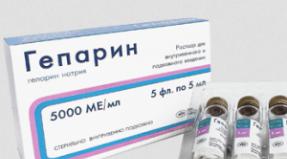Tazocin - instructions for use. Medicinal guide geotar Pharmaceutical compatibility with other drugs
Combined drug.
Piperacillin is a bactericidal semi-synthetic antibiotic wide range action, inhibits the synthesis of the cell wall of microorganisms.
Tazobactam is an inhibitor of beta-lactamases (including plasmid and chromosomal ones), which are most often the cause of resistance to penicillins and cephalosporins (including third generation cephalosporins). The presence of tazobactam significantly expands the spectrum of action of piperacillin.
Most strains of microorganisms resistant to piperacillin and producing beta-lactamases are susceptible to the drug.
Active in relation to gram-negative aerobic bacteria: Escherichia coli, Salmonella spp., Shigella spp., Citrobacter spp. (including Citrobacter freundii, Citrobacter diversus), Klebsiella spp. (including Klebsiella oxytoca, Klebsiella pneumoniae), Morganella morganii, Moraxella spp. (including Moraxella catarrhalis), Proteus spp. (including Proteus mirabilis, Proteus vulgaris), Pseudomonas aeruginosa (only piperacillin-susceptible strains) and other Pseudomonas spp. (including Burkholderia cepacia, Pseudomonas fluorescens), Neisseria spp. (including Neisseria meningitidis, Neisseria gonorrhoeae), Haemophilus spp. (including Haemophilus influenzae, Haemophilus parainfluenzae), Serratia spp. (including Serratia marcescens, Serratia liquifaciens), Pasteurella multocida, Yersinia spp., Campylobacter spp., Gardnerella vaginalis, Enterobacter spp. (including Enterobacter cloacae, Enterobacter aerogenes), Providencia spp, Stenotrophomonas maltophilia, Acinetobacter spp. (producing and non-producing chromosomal beta-lactamase); gram-negative anaerobic bacteria: Bacteroides spp. (Bacteroides fragilis, Bacteroides disiens, Bacteroides capillosus, Bacteroides melaninogenicus, Bacteroides oralis, Bacteroides distasonis, Bacteroides uniformis, Bacteroides ovatus, Bacteroides thetaiotaivomicron, Bacteroides Bacteroides bacteroides vulatus gram-positive aerobic bacteria: Streptococcus spp. (including Streptococcus pneumoniae, Streptococcus pyogenes, Streptococcus agalactiae, Streptococcus bovis), Streptococcus viridans (C and G), Enterococcus spp. (Enterococcus faecalis, Enterococcus faecium), Staphylococcus spp. (Staphylococcus aureus methicillin-susceptible strains, Staphylococcus epidermidis, Staphylococcus saprophyticus), Listeria monocytogenes, Nocardia spp .; gram-positive anaerobic bacteria: Clostridium spp. (including Clostridium perfringens, Clostridium difficile), Peptostreptococcus spp., Eubacter spp .; Veillonella spp., Actinomyces spp.
Pharmacokinetics
Suction
Cmax of piperacillin after intravenous infusion of 2.25 or 4.5 g for 30 minutes is reached immediately after its completion and is 134 and 298 μg / ml, respectively; the corresponding average plasma concentrations are 15, 24 and 34 μg / ml (the plasma concentrations of piperacillin after its administration in combination with tazobactam are similar to those with the introduction of equivalent doses of piperacillin monopreparation). The corresponding mean maximum plasma concentrations of tazobactam are 15 and 34 μg / ml, respectively.
Distribution
The connection with plasma proteins of piperacillin and tazobactam is about 30% (the metabolite of tazobactam practically does not bind to proteins). Piperacillin and tazobactam penetrate well into tissues and body fluids, including the intestinal mucosa, gall bladder, lungs, bile, bone tissue and tissues of the female reproductive system (uterus, ovaries and fallopian tubes). Average concentrations in tissues are from 50 to 100% of those in plasma. Practically does not penetrate through the intact BBB.
Excreted in breast milk.
Metabolism
Piperacillin is metabolized into a weakly active desethyl metabolite, tazobactam - into an inactive metabolite.
Withdrawal
Excreted by the kidneys through glomerular filtration and tubular secretion: piperacillin - by 68% unchanged, tazobactam - by 80% unchanged and a small amount - in the form of a metabolite. Piperacillin, tazobactam, and desethyl-piperacillin are also excreted in the bile.
Tazobactam does not cause significant changes in piperacillin pharmacodynamics. Apparently, piperacillin reduces the rate of elimination of tazobactam.
T 1/2 of piperacillin and tazobactam does not depend on the dose and duration of infusion and is 0.7-1.2 hours.
Pharmacokinetics in special clinical situations
T 1/2 of piperacillin and tazobactam lengthens with a decrease in renal blood flow (creatinine clearance): with CC less than 20 ml / min, T 1/2 of piperacillin is 2 times lengthened, tazobactam - 4 times. Correction of the dosage regimen is necessary when QC is below 40 ml / min.
By means of hemodialysis, 30-50% of the administered dose of piperacillin and tazobactam is removed, and an additional 5% in the form of a metabolite.
Peritoneal dialysis removes 6% of piperacillin and 21% of tazobactam, and an additional 18% as a metabolite of tazobactam.
With cirrhosis of the liver, T 1/2 of piperacillin increases by 25%, tazobactam - by 18% (while a significant correction of the dosage regimen is not required).
Indications
Bacterial infections caused by sensitive microflora in adults and children over 12 years old:
- infections of the lower sections respiratory tract(pneumonia, lung abscess, pleural empyema);
- abdominal infections (peritonitis, pelvioperitonitis, cholangitis, empyema of the gallbladder, appendicitis (including complicated by abscess or perforation)).
- infections urinary tract, incl. complicated (pyelonephritis, cystitis, prostatitis, epididymitis, gonorrhea, endometritis, vulvovaginitis, postpartum endometritis and adnexitis);
- infections of bones, joints, including osteomyelitis;
- infections of the skin and soft tissues (phlegmon, furunculosis, abscess, pyoderma, lymphadenitis, lymphangitis, infected trophic ulcers, infected wounds and burns);
- intra-abdominal infections (including in children over 2 years old);
- bacterial infection in patients with neutropenia (including children under 12 years of age);
- sepsis;
- meningitis;
- prevention of postoperative infection.
Dosage regimen
IV slowly in a stream (for 3-5 minutes) or drip (for at least 20-30 minutes).
Average daily dose for adults and children over 12 years old is 12 g of piperacillin and 1.5 g of tazobactam: 2.25 g (2 g of piperacillin and 0.25 g of tazobactam) every 6 hours or 4.5 g (4 g of piperacillin and 0.5 g of tazobactam) every 8 hours.
In infections caused by Pseudomonas aeruginosa, additional administration of aminoglycosides is indicated.
In chronic renal failure, the daily doses of piperacillin / tazobactam are adjusted depending on the CC: with CC 20-80 ml / min - 12 g / 1.5 g / day (4 g / 0.5 g every 8 hours), with CC less than 20 ml / min - 8 g / 1 g / day (4 g / 0.5 g every 12 hours).
For patients on hemodialysis, maximum dose is 8 g of piperacillin and 1 g of tazobactam. Since during hemodialysis 30-50% of piperacillin is washed out after 4 hours, it is necessary to prescribe 1 additional dose of 2 g of piperacillin and 0.25 g of tazobactam after each dialysis session.
The course of treatment is usually 7-10 days, according to indications it can be increased to 14 days.
To prepare a solution for intravenous administration, 0.9% sodium chloride solution, 5% dextrose solution, sterile water d / i are used as solvents. For intravenous jet administration, the contents of a vial containing 2.25 g of the drug are diluted in 10 ml of one of the above solutions. For intravenous drip administration, the contents of a vial containing 2.25 or 4.5 g of the drug are diluted, respectively, in 10 or 20 ml of 0.9% sodium chloride solution, the resulting solution is subsequently dissolved in 50 ml of one of these solutions, or in 5% dextrose solution in water, or in a mixture of 5% dextrose solution and 0.9% sodium chloride.
Diarrhea (3.8%), vomiting (0.4%), nausea (0.3%), phlebitis (0.2%), thrombophlebitis (0.3%), skin flushing (0.5%), allergic reactions(including urticaria 0.2%, itchy skin 0.5%, rash 0.6%), development of superinfection (0.2%).
Less than 0.1%: exudative erythema multiforme, maculopapular rash, eczema, myasthenia gravis, hallucinations, decreased blood pressure, myalgia in the area chest, febrile syndrome, hyperemia of the skin of the face, edema, increased fatigue, pain and hyperemia at the injection site, bleeding.
Rarely: pseudomembranous colitis.
On the part of laboratory parameters: transient leukopenia, eosinophilia, thrombocytopenia (less common than with piperacillin monotherapy), positive Coombs' reaction, hypokalemia, transient increase in the activity of hepatic transaminases and alkaline phosphatase, bilirubin, rarely - an increase in the concentration of urea and creatinine.
Contraindications for use
- hypersensitivity (including to penicillins, cephalosporins, other inhibitors of beta-lactam antibiotics);
— childhood(up to 2 years old).
With caution: severe bleeding (including history), cystic fibrosis (increased risk of hyperthermia and skin rash), pseudomembranous colitis, chronic renal failure, pregnancy, lactation.
Application during pregnancy and lactation
With caution: pregnancy, lactation.Application in children
Contraindication - children's age (up to 2 years).
Overdose
Symptoms: agitation, convulsions.
Treatment: symptomatic, incl. prescribing antiepileptic drugs (including diazepam or barbiturates), hemodialysis or peritoneal dialysis.
Pharmaceutical (in one syringe) incompatible with aminoglycosides, Ringer's solution with lactate, blood, blood substitutes or albumin hydrolysates.
Drugs that block tubular secretion increase T1 / 2 and decrease renal clearance of both piperacillin and tazobactam, while the plasma C max of both drugs remains unchanged.
When administered simultaneously with heparin, oral anticoagulants and others medicines acting on the hemostatic system requires more frequent monitoring of the blood coagulation system.
Application for impaired renal function
With caution: Chronic renal failure. In chronic renal failure, the daily doses of piperacillin / tazobactam are adjusted depending on the CC.Piperacillin + tazobactam is better tolerated and less toxic than ticarcillin, azlocillin, and carbenicillin.
In patients with hypersensitivity to penicillins, cross-allergic reactions with other beta-lactam antibiotics are possible.
Safety and efficacy of children under 2 years of age not defined.
In the event of severe persistent diarrhea, it is necessary to consider the possibility of developing pseudomembranous enterocolitis. If this complication occurs, it is necessary to discontinue the drug and prescribe orally teicoplanin or vancomycin.
With long-term treatment, it is necessary to periodically monitor the function of the kidneys, liver, blood counts (including the coagulation system).
Short-term use of high doses of antibiotics to treat gonorrhea may mask or delay symptoms incubation period syphilis, so before starting antibacterial treatment patients with gonorrhea should be examined for syphilis.
Piperacillin (piperacillin)
- tazobactam (tazobactam)
Composition and release form of the drug
2.25 g - glass bottles (1) - cardboard packs.
pharmachologic effect
Combined drug.
Piperacillin- a bactericidal semi-synthetic antibiotic of a wide spectrum of action, suppresses the synthesis of the cell wall of microorganisms.
Tazobactam- an inhibitor of beta-lactamases (including plasmid and chromosomal ones), which are most often the cause of resistance to penicillins and cephalosporins (including third generation cephalosporins). The presence of tazobactam significantly expands the spectrum of action of piperacillin.
Most strains of microorganisms resistant to piperacillin and producing beta-lactamases are susceptible.
Active in relation to gram-negative aerobic bacteria: Escherichia coli, Salmonella spp., Shigella spp., Citrobacter spp. (including Citrobacter freundii, Citrobacter diversus), Klebsiella spp. (including Klebsiella oxytoca, Klebsiella pneumoniae), Morganella morganii, Moraxella spp. (including Moraxella catarrhalis), Proteus spp. (including Proteus mirabilis, Proteus vulgaris), Pseudomonas aeruginosa (only piperacillin-susceptible strains) and other Pseudomonas spp. (including Burkholderia cepacia, Pseudomonas fluorescens), Neisseria spp. (including Neisseria meningitidis, Neisseria gonorrhoeae), Haemophilus spp. (including Haemophilus influenzae, Haemophilus parainfluenzae), Serratia spp. (including Serratia marcescens, Serratia liquifaciens), Pasteurella multocida, Yersinia spp., Campylobacter spp., Gardnerella vaginalis, Enterobacter spp. (including Enterobacter cloacae, Enterobacter aerogenes), Providencia spp, Stenotrophomonas maltophilia, Acinetobacter spp. (producing and non-producing chromosomal beta-lactamase); gram-negative anaerobic bacteria: Bacteroides spp. (Bacteroides fragilis, Bacteroides disiens, Bacteroides capillosus, Bacteroides melaninogenicus, Bacteroides oralis, Bacteroides distasonis, Bacteroides uniformis, Bacteroides ovatus, Bacteroides thetaiotaivomicron, Bacteroides Bacteroides bacteroides vulatus gram-positive aerobic bacteria: Streptococcus spp. (including Streptococcus pneumoniae, Streptococcus pyogenes, Streptococcus agalactiae, Streptococcus bovis), Streptococcus viridans (C and G), Enterococcus spp. (Enterococcus faecalis, Enterococcus faecium), Staphylococcus spp. (Staphylococcus aureus methicillin-susceptible strains, Staphylococcus epidermidis, Staphylococcus saprophyticus), Listeria monocytogenes, Nocardia spp .; gram-positive anaerobic bacteria: Clostridium spp. (including Clostridium perfringens, Clostridium difficile), Peptostreptococcus spp., Eubacter spp .; Veillonella spp., Actinomyces spp.
Pharmacokinetics
Cmax of piperacillin after intravenous infusion of 2.25 or 4.5 g for 30 minutes is reached immediately after its completion and is 134 and 298 μg / ml, respectively; the corresponding average plasma concentrations are 15, 24 and 34 μg / ml (the concentration of piperacillin after its administration in combination with tazobactam is similar to those with the introduction of equivalent doses of piperacillin monopreparation). The average C max values of tazobactam in plasma are 15 and 34 μg / ml, respectively.
Plasma protein binding of piperacillin and tazobactam is about 30% (the metabolite of tazobactam practically does not bind to proteins). Piperacillin and tazobactam penetrate well into tissues and fluids of the body, including the intestinal mucosa, gallbladder, lungs, bile, bone tissue and tissues of the female reproductive system (uterus, ovaries and fallopian tubes). Average concentrations in tissues are from 50 to 100% of those in plasma. Practically does not penetrate through the intact BBB.
Excreted in breast milk.
Piperacillin is metabolized into a weakly active desethyl metabolite, tazobactam - into an inactive metabolite.
Excreted by the kidneys through glomerular filtration and tubular secretion: piperacillin - by 68% unchanged, tazobactam - by 80% unchanged and a small amount - in the form of a metabolite. Piperacillin, tazobactam, and desethyl-piperacillin are also excreted in the bile.
Tazobactam does not cause significant changes in piperacillin pharmacodynamics. Apparently, piperacillin reduces the rate of elimination of tazobactam.
T 1/2 of piperacillin and tazobactam is 0.7-1.2 hours.
Indications
Bacterial infections caused by sensitive microflora in adults and children over 12 years of age: infections of the lower respiratory tract (pneumonia, lung abscess, pleural empyema); abdominal infections (peritonitis, pelvioperitonitis, cholangitis, empyema of the gallbladder, appendicitis (including complicated by abscess or perforation)). urinary tract infections, incl. complicated (pyelonephritis, cystitis, prostatitis, epididymitis, gonorrhea, endometritis, vulvovaginitis, postpartum endometritis and adnexitis); infections of bones, joints, including osteomyelitis; infections of the skin and soft tissues (phlegmon, furunculosis, abscess, pyoderma, lymphadenitis, lymphangitis, infected trophic ulcers, infected wounds and burns); intra-abdominal infections (including in children over 2 years old); bacterial infection in patients with neutropenia (including in children under 12 years of age); sepsis; meningitis; prevention of postoperative infection.
Contraindications
Hypersensitivity (including to penicillins, cephalosporins, other inhibitors of beta-lactam antibiotics); children's age (up to 2 years).
With care
Severe bleeding (including history), cystic fibrosis (increased risk of hyperthermia and skin rash), pseudomembranous colitis, children over 2 years of age, chronic renal failure(CC less than 20 ml / min), patients on hemodialysis, with joint application high doses, with hypokalemia, pregnancy, lactation.
Dosage
Intravenously.
Side effects
Allergic reactions: urticaria, pruritus, rash, bullous dermatitis, erythema multiforme, Stevens-Johnson syndrome, toxic epidermal necrolysis, anaphylactic / anaphylactoid reactions (including anaphylactic shock).
From the side digestive system: diarrhea, nausea, vomiting, constipation, dyspepsia, jaundice, stomatitis, abdominal pain, pseudomembranous colitis, hepatitis.
From the side of the hematopoietic organs: leukopenia, neutropenia, thrombocytopenia, anemia, bleeding (including purpura, epistaxis, increased time, bleeding), hemolytic anemia, agranulocytosis, false positive direct Coombs' test, pancytopenia, increased partial thromboplastin time, increased prothrombin time, thrombocytosis.
From the urinary system: interstitial nephritis, renal failure.
From the side nervous system: headache, insomnia, convulsions.
From the side of cardio-vascular system: lowering blood pressure, "hot flushes" of blood to the skin of the face.
Laboratory indicators: hypoalbuminemia, hypoglycemia, hypoproteinemia, hypokalemia, eosinophilia, increased activity of "hepatic" transaminases (alanine aminotransferase, aspartate aminotransferase), hyperbilirubinemia, increased activity of alkaline phosphatase, gamma-glutamyltransferase and increased concentration of urea in blood.
Local reactions: phlebitis, thrombophlebitis, hyperemia and induration at the injection site.
Others: fungal superinfection, fever, arthralgia.
Drug interactions
Combined use of the drug with probenecid increases T 1/2 and decreases renal clearance of both piperacillin and tazobactam, however, the C max in plasma of both drugs remains unchanged.
Simultaneous use of the drug and vecuronium bromide can lead to a longer neuromuscular blockade caused by the latter (a similar effect can be observed when piperacillin is combined with other non-depolarizing agents).
With simultaneous use high doses of heparin, indirect anticoagulants or other drugs affecting the blood coagulation system, including platelet function, it is necessary to monitor the state of the blood coagulation system more often.
Piperacillin may delay elimination (in order to avoid a toxic effect, it is necessary to control the concentration of methotrexate in the blood serum).
Pharmaceutical compatibility with other drugs
Do not mix in the same syringe or dropper with other medicines, incl. with aminoglycosides. When used in conjunction with other antibiotics, drugs should be administered separately; most preferably, the administration of piperacillin + tazobactam and aminoglycosides is separated in time.
Should not be used in conjunction with solutions containing and add to blood products or albumin hydrolysates.
special instructions
During treatment, especially long-term, the development of leukopenia and neutropenia is possible, therefore, it is necessary to periodically monitor the parameters of peripheral blood.
In some cases (most often in patients with renal failure), increased bleeding and concomitant changes in laboratory parameters of the blood coagulation system (blood coagulation time, platelet aggregation and prothrombin time) are likely. If bleeding occurs, the administration of the drug should be canceled and appropriate therapy should be prescribed.
Antibiotic-induced pseudomembranous colitis can present with severe, persistent, life-threatening diarrhea. Pseudomembranous colitis can develop both in the period antibacterial therapy, and after its completion. In such cases, the drug should be discontinued immediately and appropriate therapy should be prescribed (for example, by mouth, vancomycin). Drugs that inhibit intestinal motility are contraindicated.
It is necessary to bear in mind the possibility of the emergence of resistant microorganisms that can cause superinfection, especially with a long course of treatment. This drug contains 2.79 mEq (64 mg) sodium per gram of piperacillin, which may result in an overall increase in sodium intake. In patients with hypokalemia or taking drugs that promote the excretion of potassium, hypokalemia may develop during treatment (it is necessary to regularly check the content of electrolytes in the blood serum).
In patients with chronic renal failure on hemodialysis, the dose of the drug and the frequency of administration should be adjusted depending on the CC.
During use, a false-positive result of a urine test is possible when using a method based on the recovery of copper ions. Therefore, it is recommended to carry out a test based on the enzymatic oxidation of glucose (glucose oxidase method).
With caution: Chronic renal failure. In chronic renal failure, the daily doses of piperacillin / tazobactam are adjusted depending on the CC.
lyophilisate for prigot. solution for intravenous injection 2 g + 0.25 g: vial. Reg. No: LP-001658
Clinical and pharmacological group:
Antibiotic of the broad-spectrum penicillin group with a beta-lactamase inhibitor
Release form, composition and packaging
2.25 g - glass bottles (1) - cardboard packs.
Description of the active components of the drug " Piperacillin + tazobactam»
pharmachologic effect
Combined drug.
Piperacillin is a bactericidal semi-synthetic antibiotic with a broad spectrum of action that inhibits the synthesis of the cell wall of microorganisms.
Tazobactam is an inhibitor of beta-lactamases (including plasmid and chromosomal ones), which are most often the cause of resistance to penicillins and cephalosporins (including third generation cephalosporins). The presence of tazobactam significantly expands the spectrum of action of piperacillin.
Most strains of microorganisms resistant to piperacillin and producing beta-lactamases are susceptible to the drug.
Active in relation to gram-negative aerobic bacteria: Escherichia coli, Salmonella spp., Shigella spp., Citrobacter spp. (including Citrobacter freundii, Citrobacter diversus), Klebsiella spp. (including Klebsiella oxytoca, Klebsiella pneumoniae), Morganella morganii, Moraxella spp. (including Moraxella catarrhalis), Proteus spp. (including Proteus mirabilis, Proteus vulgaris), Pseudomonas aeruginosa (only piperacillin-susceptible strains) and other Pseudomonas spp. (including Burkholderia cepacia, Pseudomonas fluorescens), Neisseria spp. (including Neisseria meningitidis, Neisseria gonorrhoeae), Haemophilus spp. (including Haemophilus influenzae, Haemophilus parainfluenzae), Serratia spp. (including Serratia marcescens, Serratia liquifaciens), Pasteurella multocida, Yersinia spp., Campylobacter spp., Gardnerella vaginalis, Enterobacter spp. (including Enterobacter cloacae, Enterobacter aerogenes), Providencia spp, Stenotrophomonas maltophilia, Acinetobacter spp. (producing and non-producing chromosomal beta-lactamase); gram-negative anaerobic bacteria: Bacteroides spp. (Bacteroides fragilis, Bacteroides disiens, Bacteroides capillosus, Bacteroides melaninogenicus, Bacteroides oralis, Bacteroides distasonis, Bacteroides uniformis, Bacteroides ovatus, Bacteroides thetaiotaivomicron, Bacteroides Bacteroides bacteroides vulatus gram-positive aerobic bacteria: Streptococcus spp. (including Streptococcus pneumoniae, Streptococcus pyogenes, Streptococcus agalactiae, Streptococcus bovis), Streptococcus viridans (C and G), Enterococcus spp. (Enterococcus faecalis, Enterococcus faecium), Staphylococcus spp. (Staphylococcus aureus methicillin-susceptible strains, Staphylococcus epidermidis, Staphylococcus saprophyticus), Listeria monocytogenes, Nocardia spp .; gram-positive anaerobic bacteria: Clostridium spp. (including Clostridium perfringens, Clostridium difficile), Peptostreptococcus spp., Eubacter spp .; Veillonella spp., Actinomyces spp.
Indications
Bacterial infections caused by sensitive microflora in adults and children over 12 years old:
- infections of the lower respiratory tract (pneumonia, lung abscess, pleural empyema);
- abdominal infections (peritonitis, pelvioperitonitis, cholangitis, empyema of the gallbladder, appendicitis (including complicated by abscess or perforation)).
- urinary tract infections, incl. complicated (pyelonephritis, cystitis, prostatitis, epididymitis, gonorrhea, endometritis, vulvovaginitis, postpartum endometritis and adnexitis);
- infections of bones, joints, including osteomyelitis;
- infections of the skin and soft tissues (phlegmon, furunculosis, abscess, pyoderma, lymphadenitis, lymphangitis, infected trophic ulcers, infected wounds and burns);
- intra-abdominal infections (including in children over 2 years old);
- bacterial infection in patients with neutropenia (including children under 12 years of age);
- sepsis;
- meningitis;
- prevention of postoperative infection.
Dosage regimen
IV slowly in a stream (for 3-5 minutes) or drip (for at least 20-30 minutes).
Average daily dose for adults and children over 12 years old is 12 g of piperacillin and 1.5 g of tazobactam: 2.25 g (2 g of piperacillin and 0.25 g of tazobactam) every 6 hours or 4.5 g (4 g of piperacillin and 0.5 g of tazobactam) every 8 hours.
In infections caused by Pseudomonas aeruginosa, additional administration of aminoglycosides is indicated.
In chronic renal failure, the daily doses of piperacillin / tazobactam are adjusted depending on the CC: with CC 20-80 ml / min - 12 g / 1.5 g / day (4 g / 0.5 g every 8 hours), with CC less than 20 ml / min - 8 g / 1 g / day (4 g / 0.5 g every 12 hours).
For patients on hemodialysis, the maximum dose is 8 g of piperacillin and 1 g of tazobactam. Since during hemodialysis 30-50% of piperacillin is washed out after 4 hours, it is necessary to prescribe 1 additional dose of 2 g of piperacillin and 0.25 g of tazobactam after each dialysis session.
The course of treatment is usually 7-10 days, according to indications it can be increased to 14 days.
To prepare a solution for intravenous administration, 0.9% sodium chloride solution, 5% dextrose solution, sterile water d / i are used as solvents. For intravenous jet administration, the contents of a vial containing 2.25 g of the drug are diluted in 10 ml of one of the above solutions. For intravenous drip administration, the contents of a vial containing 2.25 or 4.5 g of the drug are diluted, respectively, in 10 or 20 ml of 0.9% sodium chloride solution, the resulting solution is subsequently dissolved in 50 ml of one of these solutions, or in 5% dextrose solution in water, or in a mixture of 5% dextrose solution and 0.9% sodium chloride.
Side effect
Diarrhea (3.8%), vomiting (0.4%), nausea (0.3%), phlebitis (0.2%), thrombophlebitis (0.3%), skin flushing (0.5%), allergic reactions (including urticaria 0.2%, skin itching 0.5%, rash 0.6%), development of superinfection (0.2%).
Less than 0.1%: exudative erythema multiforme, maculopapular rash, eczema, myasthenia gravis, hallucinations, decreased blood pressure, myalgia in the chest area, febrile syndrome, facial flushing, edema, increased fatigue, pain and hyperemia at the injection site, bleeding.
Rarely: pseudomembranous colitis.
On the part of laboratory parameters: transient leukopenia, eosinophilia, thrombocytopenia (less common than with piperacillin monotherapy), positive Coombs' reaction, hypokalemia, transient increase in the activity of hepatic transaminases and alkaline phosphatase, bilirubin, rarely - an increase in the concentration of urea and creatinine.
Contraindications
- hypersensitivity (including to penicillins, cephalosporins, other inhibitors of beta-lactam antibiotics);
- children's age (up to 2 years).
With caution: severe bleeding (including history), cystic fibrosis (increased risk of hyperthermia and skin rash), pseudomembranous colitis, chronic renal failure, pregnancy, lactation.
Pregnancy and lactation
With caution: pregnancy, lactation.
Application for impaired renal function
With caution: Chronic renal failure. In chronic renal failure, the daily doses of piperacillin / tazobactam are adjusted depending on the CC.
Application for children
Contraindication - children's age (up to 2 years).
special instructions
Piperacillin + tazobactam is better tolerated and less toxic than ticarcillin, azlocillin, and carbenicillin.
In patients with hypersensitivity to penicillins, cross-allergic reactions with other beta-lactam antibiotics are possible.
Safety and efficacy of children under 2 years of age not defined.
In the event of severe persistent diarrhea, it is necessary to consider the possibility of developing pseudomembranous enterocolitis. If this complication occurs, it is necessary to discontinue the drug and prescribe orally teicoplanin or vancomycin.
With long-term treatment, it is necessary to periodically monitor the function of the kidneys, liver, blood counts (including the coagulation system).
Short-term use of high doses of antibiotics for the treatment of gonorrhea can mask or delay the symptoms of the incubation period of syphilis, therefore, patients with gonorrhea should be examined for syphilis before starting antibiotic treatment.
Overdose
Symptoms: agitation, convulsions.
Treatment: symptomatic, incl. prescribing antiepileptic drugs (including diazepam or barbiturates), hemodialysis or peritoneal dialysis.
Drug interactions
Drug interactions
Pharmaceutical (in one syringe) incompatible with aminoglycosides, Ringer's solution with lactate, blood, blood substitutes or albumin hydrolysates.
Drugs that block tubular secretion increase T1 / 2 and decrease renal clearance of both piperacillin and tazobactam, while the plasma C max of both drugs remains unchanged.
When administered simultaneously with heparin, oral anticoagulants and other drugs acting on the hemostatic system, more frequent monitoring of the blood coagulation system is required.
1 bottle of lyophilized powder for preparation injection solution contains piperacillin 4 or 2 g and tazobactam 500 or 250 mg, respectively; in a cardboard box 1 pc.
pharmachologic effect
pharmachologic effect- bactericidal, antibacterial, antibacterial broad spectrum.Inhibits the synthesis of peptidoglycan of the microbial membrane (piperacillin), is resistant to beta-lactamases that destroy piperacillin (tazobactam).
Pharmacodynamics
It is active against (including those producing beta-lactamase) gram-negative aerobic bacteria (E. coli, Citrobacter, Klebsiella, Enterobacter, Proteus, Pseudomonas aeruginosa and other Pseudomonas, N. gonorrhoeae, Haemophilus inf.), Gram-positive streptococci (S. pneumoniae, S. pyogenes, S. bovis, S. groups C and G); enterococci (E. faecalis, E. faecium), staphylococci (St. aureus, St. epidermidis), anaerobic microorganisms (Bacteroides, B. fragilis, B. ovatus, Fusobacteria).
Indications of the drug Tazocin
Infections (moderate and severe course) lower respiratory tract, abdominal, skin and soft tissues (including cellulite, abscess, infected trophic ulcers), pelvic organs (including endometritis); bacterial infection in neutropenic patients; septicemia; severe infectious and inflammatory diseases before identification of the pathogen.
Contraindications
Hypersensitivity (including to other penicillins, cephalosporins and carbopenems).
Application during pregnancy and lactation
During pregnancy, it is prescribed strictly according to indications. Lactating women must suspend breast-feeding(piperacillin is partially excreted in milk).
Side effects
Nausea, vomiting, diarrhea, allergic reactions (skin rash, itching, urticaria, erythema); rarely - a transient increase in the blood of hepatic transaminases, alkaline phosphatase.
Method of administration and dosage
IV (2.25 g is dissolved in 5 ml of saline or 5% dextrose solution, or sterile water for injection), slowly, over 30 minutes. Adults and children over 12 years old - 2.25 g every 6 hours or 4.5 g every 8 hours (the average daily dose is 12 g of piperacillin and 1.5 g of tazobactam); for patients on hemodialysis - 2.25 g every 8 hours. The course is 7-10 days.
Precautionary measures
Storage conditions of the drug Tazocin
In a dark place at a temperature of 15-20 ° C.Keep out of the reach of children.
Shelf life of the drug Tazocin
3 years.Do not use after the expiration date printed on the package.
Synonyms for nosological groups
| ICD-10 heading | Synonyms of diseases according to ICD-10 |
|---|---|
| A41.9 Septicemia, unspecified | Bacterial septicemia |
| Severe bacterial infections | |
| Generalized infections | |
| Generalized systemic infections | |
| Generalized infections | |
| Wound sepsis | |
| Septic toxic complications | |
| Septicopyemia | |
| Septicemia | |
| Septicemia / bacteremia | |
| Septic diseases | |
| Septic conditions | |
| Septic shock | |
| Septic condition | |
| Toxic-infectious shock | |
| Septic shock | |
| Endotoxin shock | |
| J18 Pneumonia without specifying the causative agent | Alveolar pneumonia |
| Community-acquired pneumonia atypical | |
| Community-acquired pneumonia, non-pneumococcal | |
| Pneumonia | |
| Inflammatory lung disease | |
| Lobar pneumonia | |
| Lower respiratory tract infections | |
| Croupous pneumonia | |
| Lymphoid interstitial pneumonia | |
| Nosocomial pneumonia | |
| Exacerbation of chronic pneumonia | |
| Acute community-acquired pneumonia | |
| Acute pneumonia | |
| Focal pneumonia | |
| Abscessing pneumonia | |
| Bacterial pneumonia | |
| Croupous pneumonia | |
| Focal pneumonia | |
| Pneumonia with obstruction of sputum discharge | |
| Pneumonia in AIDS patients | |
| Pneumonia in children | |
| Septic pneumonia | |
| Chronic pneumonia | |
| J22 Sharp respiratory infection lower respiratory tract, unspecified | Bacterial airway disease |
| Lower respiratory tract bacterial infections | |
| Bacterial Respiratory Infections | |
| Viral Respiratory Disease | |
| Viral Respiratory Tract Infections | |
| Inflammatory airway disease | |
| Difficulty separating sputum in acute and chronic diseases respiratory tract | |
| Respiratory tract infections | |
| Respiratory tract and lung infections | |
| Lower respiratory tract infections | |
| Lower respiratory tract infections | |
| Infectious airway inflammation | |
| Respiratory tract infections | |
| Infectious lung diseases | |
| Respiratory system infections | |
| Respiratory tract infection | |
| Cold cough | |
| Pulmonary infection | |
| Acute respiratory tract infection | |
| Acute respiratory viral infection | |
| Acute inflammatory airway disease | |
| Respiratory infection | |
| Respiratory viral infections | |
| Respiratory syncytial viral infection in young children | |
| Respiratory Diseases | |
| Respiratory infections | |
| J39.9 Disease of upper respiratory tract, unspecified | ENT infections |
| Mechanical irritation of the mucous membrane of the upper respiratory tract | |
| Acute airway disease | |
| Recurrent ENT infections | |
| Chronic upper respiratory tract infection | |
| Chronic ENT infections | |
| J40 Bronchitis, not specified as acute or chronic | Allergic bronchitis |
| Asthmatic bronchitis | |
| Astmoid bronchitis | |
| Bacterial bronchitis | |
| Bronchitis | |
| Allergic bronchitis | |
| Asthmatic bronchitis | |
| Smoker's bronchitis | |
| Smokers' bronchitis | |
| Inflammation of the lower respiratory tract | |
| Disease of the bronchi | |
| Smoker's qatar | |
| Smokers' cough | |
| Cough in inflammatory diseases of the lungs and bronchi | |
| Violation of bronchial secretion | |
| Dysfunction of the bronchi | |
| Acute tracheobronchitis | |
| Subacute bronchitis | |
| Rhinotracheobronchitis | |
| Rhinotracheobronchitis | |
| Tracheobronchitis | |
| J42 Chronical bronchitis unspecified | Allergic bronchitis |
| Astmoid bronchitis | |
| Allergic bronchitis | |
| Asthmatic bronchitis | |
| Chronic bronchitis | |
| Inflammatory airway disease | |
| Disease of the bronchi | |
| Smoker's qatar | |
| Cough in inflammatory diseases of the lungs and bronchi | |
| Exacerbation of chronic bronchitis | |
| Recurrent bronchitis | |
| Chronic bronchitis | |
| Chronical bronchitis | |
| Chronic bronchitis of smokers | |
| Chronic spastic bronchitis | |
| J44.9 Chronic obstructive pulmonary disease unspecified | Bronchial obstruction |
| Broncho-obstructive syndrome | |
| Exacerbation of chronic obstructive pulmonary disease | |
| Reversible bronchial obstruction | |
| Reversible airway obstruction | |
| Obstructive pulmonary disease | |
| Airway obstruction | |
| Panbronchiolitis | |
| Panbronchitis | |
| COPD | |
| Chronic lung infection | |
| Chronic lower respiratory tract infection | |
| Chronic obstructive pulmonary disease | |
| Chronic obstructive pneumonia | |
| Chronic broncho-pulmonary diseases | |
| Chronic lung disease | |
| Chronic obstructive pulmonary disease | |
| Chronic bronchopulmonary disease | |
| L02 Skin abscess, boil and carbuncle | Abscess |
| Skin abscess | |
| Carbuncle | |
| Carbuncle skin | |
| Furuncle | |
| Skin furuncle | |
| Furuncle of the external auditory canal | |
| Furuncle of the auricle | |
| Furunculosis | |
| Boils | |
| Chronic recurrent furunculosis | |
| L03 Phlegmon | Felon |
| Panaritium with lymphangitis | |
| Phlegmon of soft tissues | |
| Phlegmon | |
| M60.0 Infectious myositis | Muscle abscess |
| Soft tissue infections | |
| Infectious myositis | |
| Pyomyositis | |
| Specific infectious processes in soft tissues | |
| M65.0 Abscess of tendon sheath | Soft tissue infections |
| M65.1 Other infectious tenosynovitis | Soft tissue infections |
| Infectious tenosynovitis | |
| M71.0 Abscess of bursa | Soft tissue infections |
| M71.1 Other infectious bursitis | Bacterial bursitis |
| Infectious bursitis | |
| Soft tissue infections | |
| N70-N77 Female pelvic inflammatory disease | Pelvic infections |
| Genital infections in women | |
| Urogenital infections | |
| N71 Inflammatory diseases of the uterus, other than the cervix | Intrauterine infections |
| Inflammatory diseases of the female genitals | |
| Inflammatory diseases of the female genital organs | |
| Genital infection | |
| Chronic endomyometritis | |
| Chronic inflammatory disease of the uterus | |
| Endometritis | |
| Endomyometritis | |
| T14.1 Open wound of unspecified body region | Secondary healing processes |
| Sluggish granulating wounds | |
| Sluggish healing wounds | |
| Sluggish wounds | |
| Deep wounds | |
| Purulent wound | |
| Granulating wounds | |
| Long-term non-healing wound | |
| Long-term non-healing wound and ulcer | |
| Long-term non-healing soft tissue wound | |
| Healing wounds | |
| Wound healing | |
| Capillary bleeding from superficial wounds | |
| Bleeding wound | |
| Radiation wounds | |
| Slowly epithelializing wounds | |
| Small cuts | |
| Festering wounds | |
| Disruption of wound healing processes | |
| Violation of the integrity of the skin | |
| Violations of the integrity of the skin | |
| Violations of the integrity of the skin | |
| Small cuts | |
| Uninfected wounds | |
| Uncomplicated wounds | |
| Operating wound | |
| Primary treatment of superficial contaminated wounds | |
| Primary wound treatment | |
| Delayed primary wound care | |
| Poorly scarring wound | |
| Poor wound healing | |
| Poor healing wound | |
| Superficial wound | |
| Superficial wound with weak exudation | |
| Wound | |
| Large wound | |
| Bite wound | |
| Wound process | |
| Wounds | |
| Sluggish wounds | |
| Stump wounds | |
| Gunshot wounds | |
| Wounds with deep cavities | |
| Difficult healing wounds | |
| Difficult healing wounds | |
| Chronic wounds | |
| T79.3 Post-traumatic wound infection, not elsewhere classified | Inflammation after surgery and injury |
| Inflammation after injury | |
| Secondary infection of lesions of the skin and mucous membranes | |
| Deep wounds | |
| Purulent wound | |
| Purulent-necrotic phase of the wound process | |
| Purulent-septic diseases | |
| Purulent wounds | |
| Purulent wounds with deep cavities | |
| Small granulating wounds | |
| Disinfection of purulent wounds | |
| Wound infections | |
| Wound infections | |
| Wound infection | |
| Infected and non-healing wound | |
| Infected postoperative wound | |
| Infected wound | |
| Infected skin wounds | |
| Infected burns | |
| Infected wounds | |
| Suppurating postoperative wounds | |
| Extensive purulent-necrotic soft tissue process | |
| Burn infections | |
| Burn infection | |
| Perioperative infection | |
| Poorly healing infected wound | |
| Postoperative and purulent-septic wound | |
| Postoperative wound infection | |
| Wound infection | |
| Wound botulism | |
| Wound infections | |
| Purulent wounds | |
| Infected wounds | |
| Reinfection of granulating wounds | |
| Post-traumatic sepsis |
Antibacterial combined drug, consisting of a semi-synthetic antibiotic piperacillin sodium and a beta-lactamase inhibitor sodium tazobactam, intended for intravenous administration.
RxList.com
Piperacillin sodium is a derivative of D (-) - alpha-aminobenzylpenicillin, molecular mass 539,5.
Tazobactam sodium, a derivative of the penicillin core, is a sulfone of penicillanic acid, molecular weight 322.3.
Pharmacology
pharmachologic effect- antibacterial broad spectrum (bactericidal).Pharmacodynamics
Mechanism of action. Piperacillin exhibits bactericidal activity, which results from inhibition of septum formation during cell division and cell wall synthesis. Piperacillin and other beta-lactam antibiotics block the terminal stage of transpeptidation of the biosynthesis of cell wall peptidoglycans in sensitive microorganisms through interaction with penicillin-binding proteins (PBPs) - bacterial enzymes that carry out this reaction. In experiments in vitro piperacillin is active against various gram-positive and gram-negative aerobic and anaerobic bacteria. Piperacillin has reduced activity against bacteria that possess certain enzymes of the beta-lactamase family, which chemically inactivate piperacillin and other beta-lactam antibiotics. Tazobactam, which has its own very weak antibacterial activity due to its low affinity for PSB, helps to restore or enhance the action of piperacillin against many resistant microorganisms. Tazobactam is a potent inhibitor of many class A beta-lactamases (penicillinases, cephalosporinases and extended-spectrum enzymes). It has inconsistent activity against class A carbapenemases and class D beta-lactamases. Tazobactam is practically inactive against most class C cephalosporinases and class B metallobetalactamases.
The combination of the properties of piperacillin and tazobactam underlies the increased activity against some microorganisms with beta-lactamases, which, when evaluated as enzyme preparations to a lesser extent were inhibited by tazobactam and other inhibitors: tazobactam does not induce chromosome-mediated production of beta-lactamases at a concentration that is achieved using the recommended dosage regimens, and piperacillin is relatively resistant to the action of a number of beta-lactamases.
Like other beta-lactam antibiotics, piperacillin, in combination with or without tazobactam, exhibits time-dependent bactericidal activity against susceptible microorganisms.
Mechanisms of development of resistance. There are three main mechanisms for the development of resistance to beta-lactam antibacterial agents: a change in target (TPP), leading to a decrease in the affinity for antibiotics; destruction of antibiotics by bacterial beta-lactamases, as well as a low intracellular concentration of antibiotics due to a decrease in their uptake or active transport of antibiotics from cells.
In gram-positive bacteria, the main mechanism of resistance to beta-lactam antibacterial agents, incl. to tazobactam and piperacillin, is a change in PSB. This mechanism underlies methicillin resistance in staphylococci and penicillin resistance in Streptococcus pneumoniae as well as Streptococcus spp. group Viridans... Resistance due to changes in PBP also develops in gram-negative strains with complex nutritional requirements, such as Haemophilus influenzae and Neisseria gonorrhoeae... The piperacillin / tazobactam combination is inactive against strains that are resistant to beta-lactam antibacterial drugs determined by changes in the SIS. As noted above, there are some beta-lactamases that are not inhibited by tazobactam.
Spectrum of antibacterial activity. The piperacillin / tazobactam combination has been shown to be active against most strains of the microorganisms listed below, as in experiments in vitro and for clinical infections that are indications for use.
Staphylococcus aureus(only methicillin-susceptible strains).
Acinetohacter haumanii, Escherichia coli, Haemophilus influenzae(excluding beta-lactamase-negative, ampicillin-resistant strains), Klebsiella pneumoniae, Pseudomonas aeruginosa(used in combination with aminoglycosides, to which the strain is sensitive).
Gram-negative anaerobes: group Bacteroides fragilis (B. fragilis, B. ovatus, B. thetaiotaomicron and B. vulgatus).
In experiments in vitro the following data were obtained, but their clinical significance is unknown.
For at least 90% of the following microorganisms, MIC in vitro less than or equal to the threshold value of sensitivity to tazobactam and piperacillin. However, the safety and efficacy of tazobactam and piperacillin when used for treatment clinical infections caused by these bacteria has not been established in adequate and well-controlled studies.
Aerobic and facultative anaerobic gram-positive microorganisms: Enterococcus faecalis(only ampicillin- or penicillin-susceptible strains), Staphylococcus epidermidis(only methicillin-susceptible strains), Streptococcus agalactiae 1 , Streptococcus pneumoniae 1 (only penicillin-susceptible strains), Streptococcus pyogenes 1 , Streptococcus spp. group Viridans 1 .
1 They do not produce beta-lactamases and are therefore sensitive only to piperacillin.
Aerobic and facultative anaerobic gram-negative microorganisms: Citrobacter koseri, Moraxella catarrhalis, Morganella morganii, Neisseria gonorrhoeae, Proteus mirabilis, Proteus vulgaris, Serratia marcescens, Providencia stuartii, Providencia rettgeri, Salmonella enterica.
Gram-positive anaerobes: Clostridium perfringens.
Gram-negative anaerobes: Bacteroides distasonis, Prevotella melaninogenica.
Pharmacokinetics
Distribution. The mean plasma C ss values of piperacillin and tazobactam are presented in Tables 1–2. Cmax of piperacillin and tazobactam in plasma is achieved immediately after the end of the iv administration. The concentration of piperacillin administered in combination with tazobactam is similar to that of piperacillin in an equivalent dose as monoterania.
Table 1
Plasma C ss values in adults after 5-minute intravenous administration, μg / ml
| Piperacillin | ||||||
| 5 min 1 | 30 minutes | 1 h | 2 h | 3 h | 4 h | |
| 2/0,25 | 237 | 76 | 38 | 13 | 6 | 3 |
| 4/0,5 | 364 | 165 | 92 | 37 | 16 | 7 |
| Tazobactam | ||||||
| Piperacillin / tazobactam dose, g | 5 min 1 | 30 minutes | 1 h | 2 h | 3 h | 4 h |
| 2/0,25 | 23,4 | 8 | 4,5 | 1.7 | 0,9 | 0,7 |
| 4/0,5 | 34,3 | 17,9 | 10,8 | 4,8 | 2 | 0,9 |
1 End of 5-minute introduction.
table 2
Plasma C ss values in adults after 30-minute administration, μg / ml
| Piperacillin | ||||||
| Piperacillin / tazobactam dose, g | 30 minutes 1 | 1 h | 1.5 h | 2 h | 3 h | 4 h |
| 2/0,25 | 134 | 57 | 29 | 17 | 5 | 2 |
| 4/0,5 | 298 | 141 | 87 | 47 | 16 | 7 |
| Tazobactam | ||||||
| Piperacillin / tazobactam dose, g | 30 minutes 1 | 1 h | 1.5 h | 2 h | 3 h | 4 h |
| 2/0,25 | 14,8 | 7,2 | 4,2 | 2,6 | 1,1 | 0,7 |
| 4 /0,5 | 33,8 | 17,3 | 11,7 | 6,8 | 2,8 | 1,3 |
1 End of 30-minute injection.
With an increase in the dose of the combination piperacillin + tazobactam from 2 g / 0.25 g to 4 g / 0.5 g, respectively, a disproportionate increase in the values (approximately 28%) of the concentration of piperacillin and tazobactam is observed.
The protein binding of both piperacillin and tazobactam is approximately 30%, while the presence of tazobactam does not affect the binding of piperacillin, and the presence of piperacillin does not affect the binding of tazobactam.
Tazobactam and piperacillin are widely distributed in tissues and body fluids, incl. in the lining of the intestines and gallbladder, lungs, bile, the female reproductive system (uterus, ovaries and fallopian tubes) and bones. Average tissue concentrations range from 50 to 100% plasma concentration.
There is no data on penetration through the BBB.
Biotransformation. As a result of metabolism, piperacillin is converted into a desethyl derivative with low activity, and tazobactam into an inactive metabolite.
Excretion. Piperacillin and tazobactam are excreted by the kidneys through CF and tubular secretion. Piperacillin is rapidly excreted unchanged, 68% of the administered dose is found in urine. Tazobactam and its metabolites are rapidly excreted by renal excretion, 80% of the administered dose is found unchanged, and the rest as metabolites. Piperacillin, tazobactam and desethylpiperacillin are also excreted in the bile.
After the administration of single and repeated doses of the piperacillin / tazobactam combination to healthy subjects, T 1/2 of piperacillin and tazobactam from plasma ranged from 0.7 to 1.2 hours and did not depend on the dose or duration of infusion. With a decrease in creatinine clearance, T 1/2 of piperacillin and tazobactam is lengthened. Tazobactam does not affect the pharmacokinetics of piperacillin. Piperacillin reduces the rate of elimination of tazobactam.
Impaired renal function. As the creatinine clearance decreases, the T 1/2 of piperacillin and tazobactam increase. With a decrease in Cl creatinine below 20 ml / min, T 1/2 of piperacillin and tazobactam increase by 2 and 4 times, respectively, compared with those in patients with normal renal function.
During hemodialysis, 30 to 50% of piperacillin and 5% of the dose of tazobactam are excreted in the form of a metabolite. During peritoneal dialysis, about 6 and 21% of piperacillin and tazobactam are excreted, respectively, and 18% of tazobactam is excreted in the form of a metabolite.
Liver dysfunction. Although in patients with impaired liver function, T 1/2 of piperacillin and tazobactam increase (by 25 and 18%, respectively), dose adjustment is not required.
The use of substances Piperacillin + Tazobactam
Systemic and / or local bacterial infections caused by microorganisms sensitive to tazobactam and piperacillin.
Adults and children over 12 years old: lower respiratory tract infections; infections urinary tract(complicated and uncomplicated); intra-abdominal infections; infections of the skin and soft tissues; septicemia; gynecological infections (including endometritis and adnexitis in postpartum period); bacterial infections in neutropenic patients (in combination with aminoglycosides); infections of bones and joints; mixed infections (caused by gram-positive / gram-negative aerobic and anaerobic microorganisms).
Children from 2 to 12 years old: intra-abdominal infections; infections with neutropenia (in combination with aminoglycosides).
Contraindications
Hypersensitivity to piperacillin, tazobactam, beta-lactam drugs (including penicillins, cephalosporins) or beta-lactamase inhibitors; children under 2 years of age.
Restrictions on use
Severe bleeding (including history); cystic fibrosis (increased risk of developing hyperthermia and skin rash); pseudomembranous enterocolitis; childhood; pregnancy; lactation period; renal failure (Cl creatinine<20 мл/мин); пациенты, находящиеся на гемодиализе; совместное применение высоких доз антикоагулянтов; гипокалиемия.
Application during pregnancy and lactation
There is insufficient data on the use of a combination of piperacillin / tazobactam or each of the active substances separately in pregnant women. Piperacillin and tazobactam cross the placental barrier. In pregnant women, this combination can be used only in cases where the expected benefit to the mother outweighs the possible risk to the fetus.
Piperacillin in low concentrations is secreted in breast milk; the release of tazobactam into milk has not been studied. During lactation, the piperacillin / tazobactam combination can be used only in cases where the expected benefit to the mother outweighs the possible risk to the breastfed baby, or breastfeeding should be discontinued during treatment.
Side effects of Piperacillin + Tazobactam substances
Side effects are listed below, classified by frequency according to categories CIOMS(Council of International Medical Scientific Organizations): very common (≥10%); often (≥1 and<10%); нечасто (≥0,1 и <1%); редко (≥0,0 и < 0,1%); очень редко (<0,01%); частота неизвестна (невозможно оценить частоту встречаемости явления).
Superinfection: often - candidiasis 1; rarely - pseudomembranous colitis.
From the side of the hematopoietic organs: often - thrombocytopenia, anemia 1; infrequently - leukopenia; rarely - agranulocytosis; frequency unknown - pancytopenia 1, neutropenia, hemolytic anemia 1, eosinophilia 1, thrombocytosis 1.
From the immune system: frequency unknown - anaphylactoid shock 1, anaphylactic shock 1, anaphylactoid reaction 1, anaphylactic reaction 1, hypersensitivity 1.
From the side of metabolism: infrequently - hypokalemia.
Mental disorders: often insomnia.
From the nervous system: often - headache; rarely - convulsions.
From the CCC side: infrequently - lowering blood pressure, phlebitis, thrombophlebitis, flushing of the skin of the face.
From the respiratory system, chest and mediastinal organs: rarely - nosebleeds; frequency unknown - eosinophilic pneumonia.
From the gastrointestinal tract: very often - diarrhea; often - abdominal pain, vomiting, constipation, nausea, dyspepsia; rarely stomatitis.
From the hepatobiliary system: frequency unknown - hepatitis 1, jaundice.
On the part of the skin and subcutaneous tissue: often - rash, itchy skin; infrequently - polymorphic exudative erythema 1, urticaria, maculopapular rash 1; rarely - toxic epidermal necrolysis 1; frequency unknown - Stevens-Johnson syndrome 1, bullous dermatitis, drug rash with eosinophilia and systemic symptoms (DRESS syndrome), acute generalized exanthematous pustulosis, exfoliative dermatitis 1, purpura.
From the musculoskeletal system: infrequently - arthralgia, myalgia.
On the part of the kidneys and urinary system: frequency unknown - renal failure, tubulointerstitial nephritis 1.
Laboratory indicators: often - an increase in the activity of hepatic transaminases (ALT, ACT), alkaline phosphatase, a decrease in the concentration of albumin and total protein in the blood, an increase in the concentration of creatinine in the blood plasma, a positive direct Coombs' test, an increase in the concentration of urea in the blood plasma, an increase in partial thromboplastin time; infrequently - an increase in the concentration of bilirubin in the blood plasma, a decrease in the concentration of glucose in the blood plasma, an increase in PT; the frequency is unknown - an increase in bleeding time, an increase in the activity of gamma-glutamyl transferase.
Others: often - an increase in body temperature, local reactions (redness, induration at the injection site); infrequently - chills.
1 Side effects identified during post-marketing studies.
RxList.com
Clinical research experience
Since clinical studies have been conducted with a different set of conditions, the incidence of adverse reactions observed in these studies may not be the same as that obtained in other studies and observed in clinical practice.
During the initial phase III clinical trials, 2621 patients worldwide received the piperacillin / tazobactam combination. In the main North American clinical trials of monotherapy (N = 830), 90% of reported adverse reactions were mild to moderate in severity and short in nature. However, in 3.2% of patients worldwide, the piperacillin / tazobactam combination was discontinued due to adverse reactions affecting mainly the skin (1.3%), including rash and itching; Gastrointestinal tract (0.9%), including diarrhea, nausea and vomiting, and due to allergic reactions (0.5%). Below are data on the incidence of adverse reactions in studies of the monotherapy regimen, grouped by organo-systemic classification.
From the gastrointestinal tract: diarrhea - 11.3%, constipation - 7.7%, nausea - 6.9%, vomiting - 3.3%, dyspepsia - 3.3%, abdominal pain - 1.3%, pseudomeranous colitis - ≤1 %.
fever - 2.4%, reaction at the injection site - ≤1%, feeling of cold - ≤1%.
From the immune system: anaphylaxis - ≤1%.
Infections and infestations: candidiasis - 1.6%.
hypoglycemia - ≤1%.
From the musculoskeletal system and connective tissue: myalgia - ≤1%, arthralgia - ≤1%.
From the nervous system: headache - 7.7%, insomnia - 6.6%.
rash (including maculopapular, bullous and urticaria) - 4.2%, pruritus - 3.1%.
From the side of the vessels: phlebitis - 1.3%, thrombophlebitis - ≤1%, hypotension - ≤1%, purpura - ≤1%, nosebleeds - ≤1%, hot flashes - ≤1%.
Clinical Trials for Hospital-acquired Pneumonia
Two clinical studies have been conducted for nosocomial lower respiratory tract infections. In one of them, 222 patients received a combination of piperacillin + tazobactam at a dose of 4.5 g every 6 hours in combination with an aminoglycoside and 215 patients received imipenem / cilastatin (500/500 mg every 6 hours) in combination with an aminoglycoside. In this study, treatment-related side effects were observed in 402 patients - 204 (91.9%) in the piperacillin + tazobactam group and 198 (92.1%) in the imipenem / cilastatin group. 25 patients (11%) in the first group and 14 patients (6.5%) in the second group (p> 0.05) discontinued treatment due to side effects.
The second study used a dose regimen of 3.375 g every 4 hours in combination with an aminoglycoside.
Adverse reactions that have occurred in studies using a combination of piperacillin + tazobactam and an aminoglycoside are listed below. For adverse reactions noted in both studies, a higher frequency is given.
On the part of the blood and lymphatic system: thrombocythemia - 1.4%, anemia - ≤1%, thrombocytopenia - ≤1%, eosinophilia - ≤1%.
From the gastrointestinal tract: diarrhea - 20%, constipation - 8.4%, nausea - 5.8%, vomiting - 2.7%, dyspepsia - 1.9%, abdominal pain - 1.8%, stomatitis - ≤1%.
General disorders and reactions at the injection site: fever - 3.2%, reaction at the injection site - ≤1%.
Infections and infestations: oral candidiasis - 3.9%, candidiasis - 1.8%.
Deviations of laboratory parameters: an increase in the level of residual urea nitrogen in the blood - 1.8%, an increase in the level of creatinine in the blood - 1.8%, deviations in liver test indicators - 1.4%, an increase in ALP activity - ≤1%, an increase in AST activity - ≤1%, increased ALT activity - ≤1%.
Metabolic and nutritional disorders: hypoglycemia - ≤1%, hypokalemia - ≤1%.
From the nervous system: headache - 4.5%, insomnia - 4.5%.
From the urinary system: impaired renal function - ≤1%.
On the part of the skin and subcutaneous tissues: rash - 3.9%, itching - 3.2%.
From the side of the vessels: thrombophlebitis - 1.3%, hypotension - 1.3%.
Pediatrics
Studies of the combination of piperacillin + tazobactam in children and adolescents indicate a similar safety profile with that observed in adult patients. In a prospective, randomized, comparative, open-label clinical trial involving pediatric patients with serious intra-abdominal infections (including appendicitis and / or peritonitis), 273 patients received a combination of piperacillin + tazobactam (112.5 mg / kg every 8 hours) and 269 patients received cefotaxime ( 50 mg / kg) plus metronidazole (7.5 mg / kg) every 8 hours. In this study, treatment-related side effects were noted in 146 patients - 73 (26.7%) in the piperacillin + tazobactam group and 73 (27.1%) in the group receiving cefotaxime + metronidazole. In 6 patients (2.2%) in the piperacillin + tazobactam group and in 5 patients in the cefotaxime + metronidazole group, treatment was stopped due to adverse reactions.
Laboratory deviations observed during clinical trials
In published clinical trials, including a study for hospital-acquired pneumonia that used a higher dose of piperacillin + tazobactam in combination with an aminoglycoside, laboratory changes include:
hematological parameters- a decrease in the level of Hb and hematocrit, thrombocytopenia, an increase in the number of platelets, eosinophilia, leukopenia, neutropenia. Patients with such changes were discontinued, some of them had concomitant systemic symptoms (eg, fever, coldness, chills);
coagulation indicators- positive direct Coombs' test, increased PT, lengthening of partial thromboplastin time;
liver function indicators- short-term increase in the level of AST, ALT, alkaline phosphatase, bilirubin;
kidney function indicators- an increase in the level of serum creatinine, residual nitrogen of urea in the blood.
In addition, laboratory abnormalities include electrolyte disturbances (for example, an increase and decrease in sodium, potassium and calcium), hyperglycemia, a decrease in total protein or albumin, a decrease in blood glucose, a decrease in gamma-glutamyl transferase levels, hypokalemia, and an increase in bleeding time.
Post-registration observation experience
In addition to those noted in clinical studies, in the post-registration period, the following adverse reactions were identified when using a combination of piperacillin + tazobactam.
Since these reactions have been reported voluntarily and from a population of unknown size, it is not always possible to realistically estimate their frequency or establish a causal relationship with drug exposure.
From the gastrointestinal tract: hepatitis, jaundice.
From the side of the blood: hemolytic anemia, agranulocytosis, pancytopenia.
From the immune system: hypersensitivity reactions, anaphylactic / anaphylactoid reactions (including shock).
From the side of the kidneys: interstitial nephritis.
On the part of the skin and its appendages: erythema multiforme, Stevens-Johnson syndrome.
Additional data for piperacillin
From the musculoskeletal system: increase in muscle relaxation time (see "Interaction").
Post-registration observations in children and adolescents indicate a similar safety profile with that observed in adult patients.
Interaction
The combined use of a combination of piperacillin + tazobactam with probenecid increases T 1/2 and decreases the renal clearance of both piperacillin and tazobactam, however, the C max in plasma remains unchanged.
No pharmacokinetic interaction was found between piperacillin + tazobactam and vancomycin. At the same time, in a limited number of retrospective studies, an increase in the incidence of acute kidney damage was noted in patients who received therapy with piperacillin and tazobactam in conjunction with vancomycin, compared with patients receiving only vancomycin.
Piperacillin incl. and when combined with tazobactam did not have a significant effect on the pharmacokinetics of tobramycin both in patients with intact renal function and in patients with mild to moderate renal impairment. The pharmacokinetics of piperacillin, tazobactam and metabolites also did not significantly change with the use of tobramycin.
The simultaneous use of a combination of piperacillin + tazobactam and vecuronium bromide can lead to a longer neuromuscular blockade caused by the latter (a similar effect can be observed when piperacillin is combined with other non-depolarizing muscle relaxants).
With the simultaneous use of a combination of piperacillin + tazobactam and heparin, indirect anticoagulants or other drugs that affect the blood coagulation system, incl. on the function of platelets, it is necessary to monitor the state of the blood coagulation system more often.
Piperacillin can delay the excretion of methotrexate (in order to avoid toxic effects, it is necessary to control the concentration of methotrexate in the blood serum).
Influence on the results of laboratory and other diagnostic tests. When using a combination of piperacillin + tazobactam, a false-positive result of a glucose test in urine is possible when using a method based on the reduction of copper ions. Therefore, it is recommended to carry out a test based on the enzymatic oxidation of glucose.
There is evidence that patients receiving a combination of piperacillin + tazobactam may have false positive test results for galactomannan when using test systems Platelia Aspergillus ELISA... Cross-reactions with non-Aspergillus polysaccharides and polyfuranoses have been reported with the test Platelia Aspergillus... Therefore, positive test results for galactomannan in patients receiving tazobactam and piperacillin should be viewed critically and rechecked using other diagnostic methods.
Combined use with aminoglycosides. With the simultaneous administration of a combination of piperacillin + tazobactam and aminoglycosides, their inactivation is possible, therefore these drugs are recommended to be administered separately. In situations where co-administration is preferred, solutions of the combination of piperacillin + tazobactam and aminoglycosides should be prepared separately. Only a V-shaped catheter should be used for insertion. If the above conditions are met, the piperacillin + tazobactam combination can be administered using a V-shaped catheter only with amikacin and gentamicin and using compatible solvents.
Pharmaceutical compatibility with other drugs. The combination of piperacillin + tazobactam should not be mixed in the same syringe or dropper with drugs other than gentamicin and amikacin, since there is no data on compatibility.
When using a combination of piperacillin + tazobactam in conjunction with other antibiotics, drugs should be administered separately.
Given the chemical instability of the piperacillin + tazobactam combination, it should not be used in conjunction with solutions containing sodium bicarbonate.
The piperacillin + tazobactam combination should not be added to blood products or albumin hydrolysates.
RxList.com
Piperacillin can inactivate aminoglycosides, converting them to microbiologically inactive amides.
In vivo inactivation. With the simultaneous use of aminoglycosides with piperacillin in patients with end-stage kidney disease requiring hemodialysis, the concentration of aminoglycosides (especially tobramycin) may decrease significantly, and its level must be monitored.
Sequential use of a combination of piperacillin + tazobactam and tobramycin in patients with mild to moderate renal failure led to a slight decrease in the concentration of tobramycin, which did not require dose adjustment.
In vitro inactivation. Since aminoglycosides in vitro are inactivated by piperacillin, the combination of piperacillin + tazobactam and aminoglycosides is recommended to be administered separately. If concomitant therapy with aminoglycosides is indicated, then reconstitution, dilution and administration of a combination of piperacillin + tazobactam and an aminoglycoside should be carried out separately.
The piperacillin + tazobactam EDTA combination is compatible with amikacin and gentamicin for simultaneous V-catheter infusion using specific solvents and concentrations. The combination of piperacillin + tazobactam is incompatible with tobramycin for simultaneous infusion through a V-catheter.
Probenecid. With the concomitant use of probenecid and a combination of piperacillin + tazobactam, the T 1/2 of piperacillin is lengthened by 21% and tazobactam by 71%, because probenecid inhibits tubular secretion of both piperacillin and tazobactam. Probenecid should not be used in conjunction with the piperacillin + tazobactam combination, unless the expected benefits of their combined use outweigh the possible risks.
Anticoagulants. With the simultaneous use of high doses of heparin, oral coagulants or other drugs that may have an effect on the blood coagulation system or platelet function, it is necessary to more often determine and regularly monitor the coagulation parameters (see "Precautions").
Vecuronium bromide. Piperacillin, when used concomitantly with vecuronium bromide, lengthens the neuromuscular blockade caused by vecuronium bromide. The use of a combination of piperacillin + tazobactam together with vecuronium bromide can have a similar effect. It is expected that neuromuscular blockade caused by any non-depolarizing muscle relaxant, due to a similar mechanism of action, may be prolonged in the presence of piperacillin. Adverse reactions associated with neuromuscular blockade should be monitored.
Methotrexate. Limited evidence suggests that co-administration of methotrexate and piperacillin may decrease methotrexate clearance due to their competition for renal secretion. The effect of tazobactam on methotrexate elimination has not been evaluated. If concomitant therapy is required, serum methotrexate concentrations should be measured frequently, and signs and symptoms indicative of methotrexate toxicity should be monitored.
Overdose
Symptoms: nausea, vomiting, diarrhea, increased neuromuscular irritability and seizures.
Treatment: depending on the clinical manifestations, symptomatic treatment is prescribed. Hemodialysis may be used to reduce high serum piperacillin or tazobactam levels.
RxList.com
After the administration of a single dose of 3.375 g of the piperacillin + tazobactam combination, the proportion of piperacillin and tazobactam removed by hemodialysis was 31 and 39%, respectively.
Route of administration
Precautions for Piperacillin + Tazobactam Substances
Before starting treatment with a combination of piperacillin + tazobactam, the patient should be interviewed in detail to identify possible history of hypersensitivity reactions, incl. associated with penicillins or cephalosporins. Severe allergic reactions are more likely to develop in patients who are hypersensitive to multiple allergens. Such reactions require discontinuation of the administration and use of epinephrine and other emergency measures.
In patients receiving a combination of piperacillin + tazobactam, there have been cases of severe skin reactions, such as Stevens-Johnson syndrome and toxic epidermal necrolysis, drug rash with eosinophilia and systemic symptoms (DRESS syndrome), acute generalized exanthematous pustulosis. If a rash occurs, patients should be closely monitored and, if symptoms progressed, discontinue the piperacillin + tazobactam combination.
Antibiotic-induced pseudomembranous colitis can present with severe, prolonged, life-threatening diarrhea. Pseudomembranous colitis can develop both during the period of antibiotic therapy and after its completion. In such cases, the combination of piperacillin + tazobactam should be discontinued immediately and appropriate therapy should be prescribed (eg vancomycin, oral metronidazole). Drugs that inhibit peristalsis are contraindicated.
When treating with a combination of piperacillin + tazobactam, especially long-term, leukopenia and neutropenia may develop, therefore, it is necessary to periodically monitor peripheral blood parameters.
In patients with renal insufficiency or on hemodialysis, the dose and frequency of administration should be adjusted based on the degree of renal impairment.
In some cases (most often in patients with renal failure), increased bleeding and concomitant changes in laboratory parameters of the blood coagulation system (blood clotting time, platelet aggregation and PT) are likely. If bleeding occurs, treatment with a combination of piperacillin + tazobactam should be discontinued and appropriate therapy should be prescribed.
It is necessary to bear in mind the possibility of the appearance of resistant microorganisms that can cause superinfection, especially with a long course of treatment with a combination of piperacillin + tazobactam. Patients should be closely monitored during therapy. If superinfection develops, adequate measures should be taken.
As with the use of other drugs of the penicillin series, against the background of therapy with a combination of piperacillin + tazobactam, neurological complications may develop, manifested by convulsions. These reactions are most often observed with the use of a combination of piperacillin + tazobactam in high doses, especially in patients with impaired renal function.
This combination contains 2.84 meq (65 mg) sodium per gram of piperacillin, which may result in an overall increase in patient intake of sodium. In patients with hypokalemia or receiving drugs that promote the excretion of potassium, hypokalemia may develop during treatment with a combination of piperacillin + tazobactam (it is necessary to regularly check the content of electrolytes in the blood serum).
There is no experience of use in children under 2 years of age.
Influence on the ability to drive vehicles and work with mechanisms. Studies of the effect of the combination of piperacillin + tazobactam on the ability to drive and engage in potentially hazardous activities that require increased concentration of attention and speed of psychomotor reactions have not been conducted. If undesirable phenomena from the central nervous system appear (convulsions), one should refrain from performing these types of activities.
RxList.com
Hypersensitivity reactions. Serious and sometimes fatal hypersensitivity reactions (anaphylactic / anaphylactoid, including shock) have been observed in patients receiving therapy with a combination of piperacillin + tazobactam. These reactions are more likely in patients with a history of hypersensitivity to penicillin, cephalosporin, or carbapenem, or a history of multiple allergens. Before prescribing therapy with a combination of piperacillin + tazobactam, it is necessary to carefully interview the patient for previous hypersensitivity reactions. If an allergic reaction occurs, treatment should be discontinued and appropriate therapy prescribed.
Serious skin reactions. Cases of serious skin reactions such as Stevens-Johnson syndrome and toxic epidermal necrolysis have been reported in patients receiving the piperacillin + tazobactam combination. With the development of a skin rash, the patient must be carefully monitored and with the progression of the lesion, treatment should be discontinued.
Diarrhea associated with Clostridium difficile. The use of almost all antibacterial drugs, incl. piperacillin / tazobactam combination has been associated with the development of diarrhea associated with Clostridium difficile (Clostridium difficile associated diarrhea, CDAD), which can range from mild diarrhea to fatal colitis. Antibacterial drug treatment affects the normal flora of the colon, leading to overgrowth Clostridium difficile.
Clostridium difficile produces toxins A and B, which are involved in the development of CDAD. Strains with overproduction of toxins increase morbidity and mortality because the infections they cause may be resistant to antimicrobial therapy and require colectomy. Suspected CDAD should be considered in all patients with diarrhea associated with antibacterial drugs. Careful examination of the patient record is necessary, as CDAD can occur more than two months after the use of antibacterial drugs.
If CDAD is suspected or confirmed, it is necessary to cancel all antibacterial drugs, except for those acting directly on Clostridium diffcile... According to clinical indications, it is necessary to take measures to restore the balance of fluid and electrolytes, additional intake of protein, antibiotic therapy in relation to Clostridium difficile and a surgical assessment of the situation.
Hematological effects. Some patients receiving beta-lactam drugs, including piperacillin, showed signs of bleeding. These signs have sometimes been associated with abnormalities in coagulation tests, such as clotting time, platelet aggregation and PT, and are more likely to occur in patients with renal failure. If signs of bleeding appear, the use of a combination of piperacillin + tazobactam should be suspended and appropriate treatment should be prescribed.
Leukopenia / neutropenia associated with the combination of piperacillin + tazobactam was reversible and more often occurred with long-term use.
Periodic assessment of hematopoietic function should be carried out, especially during long-term therapy, i.e. ≥21 days (see "Side Effects").
Action on the central nervous system. As in the case of other penicillins, patients may experience neuromuscular excitability or convulsions when administered intravenously at higher than recommended doses (in particular, in the presence of renal failure).
Electrolyte changes. The piperacillin + tazobactam combination contains 2.79 meq (64 mg) sodium per gram of piperacillin. This should be taken into account when treating patients with sodium restriction. In patients with low potassium stores, electrolyte levels should be monitored periodically, and hypokalemia should be taken into account in patients with low potassium stores and receiving cytotoxic or diuretic therapy.
Development of drug-resistant bacteria. Prescribing a piperacillin + tazobactam combination in the absence of proven infection or in the absence of a serious suspicion of infection is unlikely to be successful in patient care and increases the risk of developing drug-resistant bacteria.
Children. The use of the piperacillin + tazobactam combination in children 2 months of age or older with appendicitis and / or peritonitis is supported by the results of well-controlled studies and pharmacokinetic studies in adults and children and adolescents, including a prospective randomized, comparative, open-label clinical trial involving 542 children aged 2– 12 years old with complicated intra-abdominal infections, in which 273 patients received a combination of piperacillin + tazobactam. The efficacy and safety of this combination in children under 2 months of age has not been established.
It has not been established how to adjust the dose of the piperacillin + tazobactam combination in children and adolescents with renal failure.
Aged people. There is no increased risk of adverse reactions in patients over 65 years old only because of age. However, in the presence of renal failure, dose adjustment is required.
In general, it is necessary to approach the dose selection for an elderly patient with caution, usually starting treatment at the lower value of the dose range, taking into account the higher frequency of decreased liver, kidney or heart function, as well as concomitant diseases or other drug therapy.
The piperacillin + tazobactam combination contains 64 mg (2.79 meq) sodium per gram of piperacillin. At the usually recommended doses, patients will receive 768 to 1,024 mg sodium per day (33.5 to 44.6 meq). Elderly patients may respond with reduced natriuresis to salt loading. This can be clinically important in diseases such as CHF. It is known that the combination of piperacillin + tazobactam is largely excreted by the kidneys, and in patients with impaired renal function, the risk of toxic reactions to this combination may increase. Since elderly patients are more likely to have reduced renal function, caution should be exercised in dose selection and, if possible, renal function should be monitored.
Renal failure In patients with Cl creatinine ≤40 ml / min and who are on dialysis (hemodialysis and continuous ambulatory peritoneal dialysis), the dose of the combination of piperacillin + tazobactam for i / v
0
0



















